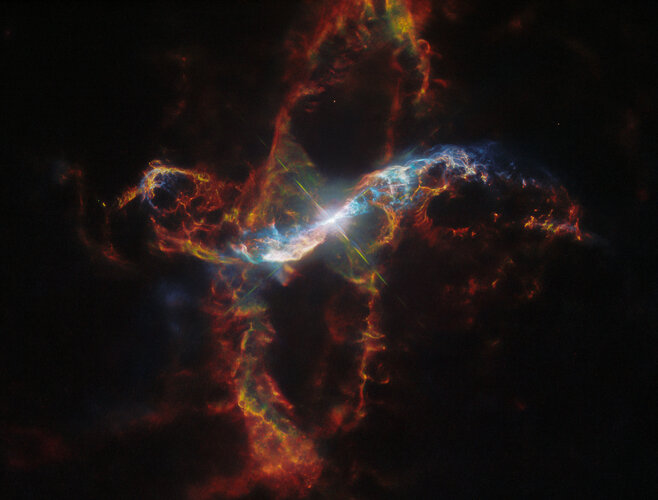
This outburst ejects geyser-like filaments shooting out from the core, forming loops and trails as the plasma emerges in streamers. The plasma is twisted by the force of the explosion and channeled upwards and outwards by strong magnetic fields. The outflow appears to bend back on itself into a spiral pattern. The filaments are glowing in visible light because they are energized by blistering radiation from the stellar duo that is R Aquarii. The nebula around the binary star is known as Cederblad 211, and may be the remnant of a past nova.
The scale of the event is extraordinary even in astronomical terms since emitting material can be traced out to at least 400 billion km – or 2500 times the distance between the Sun and Earth – from the central core.
The ESA/Hubble team has developed a unique timelapse of the object consisting of multiple observing programmes that span from 2014 to 2023. Across the five images, the rapid and dramatic evolution of the binary star and its surrounding nebula can be seen. The binary star dims and brightens, seen by the size of the red diffraction spikes around it, due to the strong pulsations of the red giant star. The nebula is shown in mostly green colours, but bluer parts of it come in and out of view: this is because they are being illuminated as the lighthouse-like beam of light from the spinning binary star sweeps over them.
Notes
[1] A nova, from the Latin stella nova meaning 'new star', is the temporary appearance of a new and bright star in the sky. The 'new' star is actually a white dwarf in a close binary system, which has temporarily greatly increased in brightness due to a thermonuclear explosion at its surface; this explosion is what astronomers refer to as a nova. A supernova gets its name from the same source, but is a somewhat different and much more energetic astrophysical phenomenon.
More information
The Hubble Space Telescope is a project of international cooperation between ESA and NASA.
The Hubble observations featured in this release include those from program 16312 (PI: M. Karovska), 16055 (PI: M. Karovska), 14847 (PI: M. Karovska), and 13339 (PI: M. Stute).
Contact:
ESA Media relations



